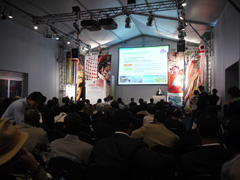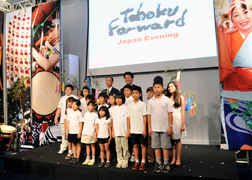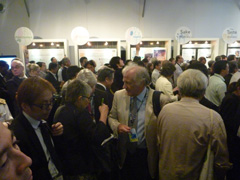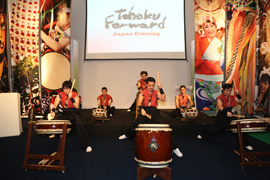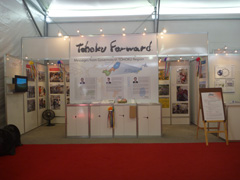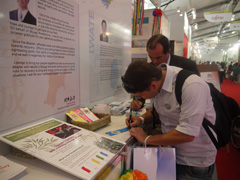On the occasion of the United Nations Conference on Sustainable Development (Rio+20) in Rio de Janeiro, Brazil, the Ministry of Foreign Affairs (MOFA) of Japan held a seminar along with "Japan Evening"– collectively called Japan Day – at the Japan Pavilion on June 20 (Wednesday). The Japan Day highlighted the state of reconstruction in the Tohoku region after the Great East Japan Earthquake and showcased the multifaceted appeal of Japan. Between June 13 (Wednesday) and 24 (Sunday), the pavilion also included an exhibition booth that featured photographs depicting reconstruction efforts. An overview of these events and the exhibition is given below (see attachments for the programs of the seminar and the Japan Evening).
1. Seminar
Under the theme "Reconstruction of Sustainable Societies after the Great East Japan Earthquake," the seminar featured lectures and a discussion by those involved in the Tohoku reconstruction as well as environmental officials and experts. Many people attended the seminar, exceeding the 150-person capacity. The event drew favorable responses, with participants saying that they were impressed by how rapidly the reconstruction process was progressing as well as by the fortitude and resilience of people in the affected areas, that they well understood how hard Japan was working toward reconstruction, that Japan’s reconstruction plans and processes would serve as a model for the world, and that they wanted to communicate the lessons Japan learned from the disaster to their compatriots back home. The seminar provided an opportunity for Japan to effectively demonstrate its commitment to forge ahead with reconstruction work while respecting the environment.
2. Japan Evening-TOHOKU FORWARD-
With the concept of TOHOKU FORWARD, the Japan Evening provided an opportunity to communicate to the world the progress in the reconstruction of Tohoku and the region’s attractive features in cooperation with Iwate, Miyagi, and Fukushima Prefectures in the region, as well as Brazil-based organizations of Japanese descendants, including the associations of those from these prefectures. The event was a huge success. The venue was filled to overflowing with more than 300 participants from countries around the world as well as international organizations. They included the Minister, Private Secretary for National Policy, Presidency, Nicaragua; the Mayor of Keila Town, Estonia; the Consul General of Rumania in Rio; the Director-General of Environment Quality Promotion Department of the Lao PDR; and the Director-General of UNIDO, the Secretary-General of UNEP, and the Secretary-General of IMO.
The address by Minister for Foreign Affairs Koichiro Gemba kicked off the Japan Evening program. Students from a local Japanese school and a Japanese language model school presented messages of encouragement to the representatives of Iwate, Miyagi, and Fukushima Prefectures, who in turn gave presentations on their reconstruction plans and attractive features of their prefectures. This was followed by the tasting of Japanese food and sake including local cuisine of Tohoku; a demonstration of pounding steamed rice into rice cake dough by the Associação Iwate Kenjinkai do Brasil, the Brazil-based association of Japanese descendents from Iwate Prefecture; and a live performance by Wadaiko Sho, a Sao Paulo-based Japanese drumming group, dispatched by the Japan Foundation. Their performance featured Tohoku folk songs.
At the venue, PR videos on reconstruction were screened. Also on display were banners used at the Tohoku Rokkon Festival, as well as Tanabata Festival decorations made by the Associação Miyagui Kenjinkai do Brasil, the Brazil-based association of Japanese descendents from Miyagi Prefecture. PR booths for Iwate, Miyagi, and Fukushima were set up to communicate the progress in reconstruction work and promote the charms of the three prefectures. These booths featured a panel presentation and PR literature that explained the prefectures’ own reconstruction plans and visions for the future. The Iwate booth offered visitors cotton facecloths with Japanese calligraphy denoting "reconstruction of Sanriku" (the Pacific coastal area of the northern part of the Tohoku region). The Fukushima booth set up a board on which visitors were free to write a message of encouragement to the people of Fukushima, and displayed bottle armor that was modeled after samurai armor.
Participants listened intently to the explanations given by the representatives of the prefectures. They also tasted local cuisine and sake from Tohoku and enjoyed the Japanese drumming performance. Participants were able to get a better picture of the vitality and allure of the region.
3. Exhibition
MOFA set up an exhibition booth in the Japan Pavilion for the entirety of the open period for this pavilion (June 13 (Wednesday) -24 (Sunday)). The booth featured a panel of messages from the governors of the three Tohoku prefectures, an exhibition of photographs depicting reconstruction efforts titled "Tohoku Region-Rebuilding for a Better Tomorrow-", the screening of videos showing the state of reconstruction as well as Japanese environmental and disaster-prevention technologies, and PR literature. The booth had a special section where visitors could write a message of hope and encouragement to Tohoku on colored strips of paper on sticks of bamboo for the Tanabata festival, one of the Japan’s traditional festivals. It is said that wishes written on strips of paper hung on a bamboo branch during Tanabata come true. Many people from around the world left a message. A total of more than 18,000 people visited the venue over the open period.
Back to Index
